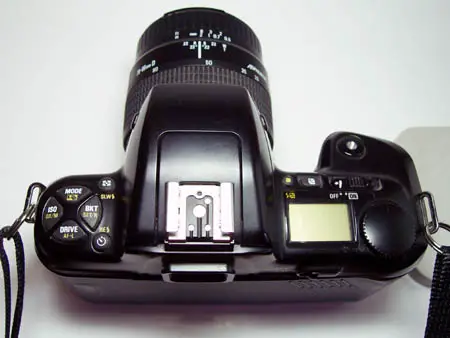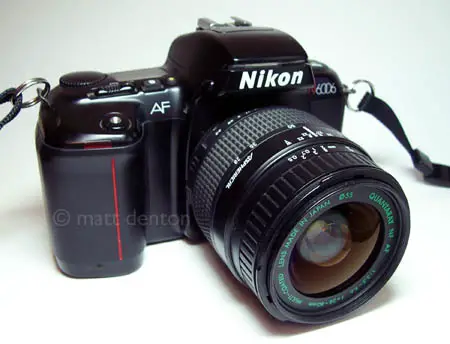- Produced 1990 Nippon Kogaku K.K., Japan
- Film type 135 (35mm)
- Picture size 24mm x 36mm
- Weight 23oz (650g) body only, without battery
- Lens Nikon AF mount Quantaray 28-80mm zoom
- Filter size 55mm
- Shutter electronic focal plane (metal)
- Shutter speeds B, 30s-1/2000
- Viewfinder SLR (92% coverage)
- Exposure meter TTL CdS with LCD shutter speed readout in VF, -2 to +2 EV adjust
- EV Range -1 to 19 at ISO 100
- Modes Aperture priority, full automatic or manual modes
- ASA 25-5000 DX, 6-6400 non-DX
- Battery 6V lithium CR-P2, 223A
- Self-timer
- Integrated autowinder, 1.2-2.0fps
- Built-in pop-up flash (GN 13)
- Autofocus or manual focus
- Close cousins: N6000, N8008s, T-600, T-601, T-801s (s=spot)
Overview
There was a point early in my wife’s ‘Room Mom’ career at school when she began to have camera envy. Nothing against our super-full-featured Canon Classic 120, of course, but next to the Canon and Nikon SLRs that other parents seemed to always have… Especially considering the closeups of kids’ artwork you can frame with an SLR that you can’t with a compact and its offset viewfinder…. Well, anyway, she began not-so-subtly hinting that she could really use a ‘real camera’. SO rather than try and show her how to use one of my many manual SLRs, I knew she would be better off in the long run with a semi-professional SLR that could act like a point & shoot when needed. Something that wasn’t over-the-top expensive, and whose lenses would still be useful should we ever upgrade to a digital SLR. That basically narrowed it down to Nikon and Canon right there for me, and though we’ve always loved our Canon compacts I already had a few Nikon AI mount lenses…
Now, you’ll think I’m nuts (if you don’t already!) but I compared the specs and build of the stock Nikon-branded zoom vs the Quantaray and they appear to me to be identical. I know Nikon farmed out its consumer level SLRs to OEMs, I’m sure they did the same with the consumer level lenses. I have little doubt that this Quantaray comes from the same OEM as the Nikon brand. Certainly it takes surprisingly nice pictures for a ‘generic’ lens. In fact I never take it off, it’s good throughout its range!
The N6006 itself is a multimode semi-profssional AF autowinding SLR, with more features than you can possibly remember without cribbing notes on the back of your hand. In fact this is one of those cameras I definitely recommend getting either a copy of the manual or at least a Magic Lantern Guide for. Let me put it this way — there’s a completely separate manual just for using flash with this camera…!
What the heck are all those buttons?
Fageddaboutit. Push and hold two of the four buttons marked MODE, ISO, BKT, DRIVE, and the camera will revert to ‘simple’ mode which is where you generally want to be with this one. Then you can use it as a hefty point & shoot with all of the best features activated: single frame film advance, Matrix Metering (woo!), Multi-Program exposure control, normal flash sync AND automatic balanced fill flash (woo woo!). This camera does spot, center-weighted and matrix metering, but matrix is by far the coolest, it compares 5 zones and exposes based on the average of the zones. Combine this with the automatic balanced fill flash and you get the ability to take a flash photo/natural light combination photo hat looks like it was done with a crew of assistants holding bounce cards! Yeah!

Frankly, this camera is so full of features that I’m going to say for more info consult the manual, hate to do that but you can literally write a book on all the things this camera can do. Say, like a Magic Lantern Guide for example! For basic operation, see above.
Repairs
The Achilles heel of this (like many modern plastic cameras) is its battery cover. This camera got dropped from a height of about two feet onto a hardwood floor in a restaurant in Oregon and the battery cover broke apart. I recovered three of the pieces but the tiny latch spring was lost forever in the dim light, and the camera spent the rest of the vacation with a piece of packing tape holding the battery door shut. (Tacky tourists eh!) I ordered a replacement from an ebay seller from our hotel so it was waiting when we returned, and then that one eventually split apart in a similar fashion to be epoxied by me later. Essentially, there is a metal plate holding down the latch and spring, and the plate is somewhat weakly held on by four dots of plastic molded from the the door itself. If & when these tabs lose their holding power, there’s nothing to do but epoxy the metal cover down, which does seem to work fine. Kind of annoying though.
Tips & Tricks
BIGGEST TIP: the lens *must* be set to the smallest aperture for the camera to shoot at all in auto mode. This gives the camera the lens’ capability. You will get a somewhat inexplicable flashing E error if the aperture ring is not set to the smallest aperture, and this is the first place you should look if the camera doesn’t fire. Other than that, the N6006 (and N8008) has more features than you can shake a stick at, best bet is to keep in PM mode and fire away.
The pop-up flash recycles very quickly and is good for general purpose photos with a general purpose lens. However with a hood or with a larger lens like the Sigma AF 28-200 I bought, it has such girth and length (oh my!) that it vignettes the flash and you get a shadow on your pictures. So use an accessory flash with bigger-than-standard lenses or if using a hood.
In fact, with the matrix metering the flash capabilities of this and the N8008 are impressive enough that there is a separate manual for using this camera with flash. I bought one, I’m still digesting it. To be fair, it kind of goes against the point-and-shoot-ivity of the way we use this camera.
Related Links
- Plenty of info at this great site in Malaysia
